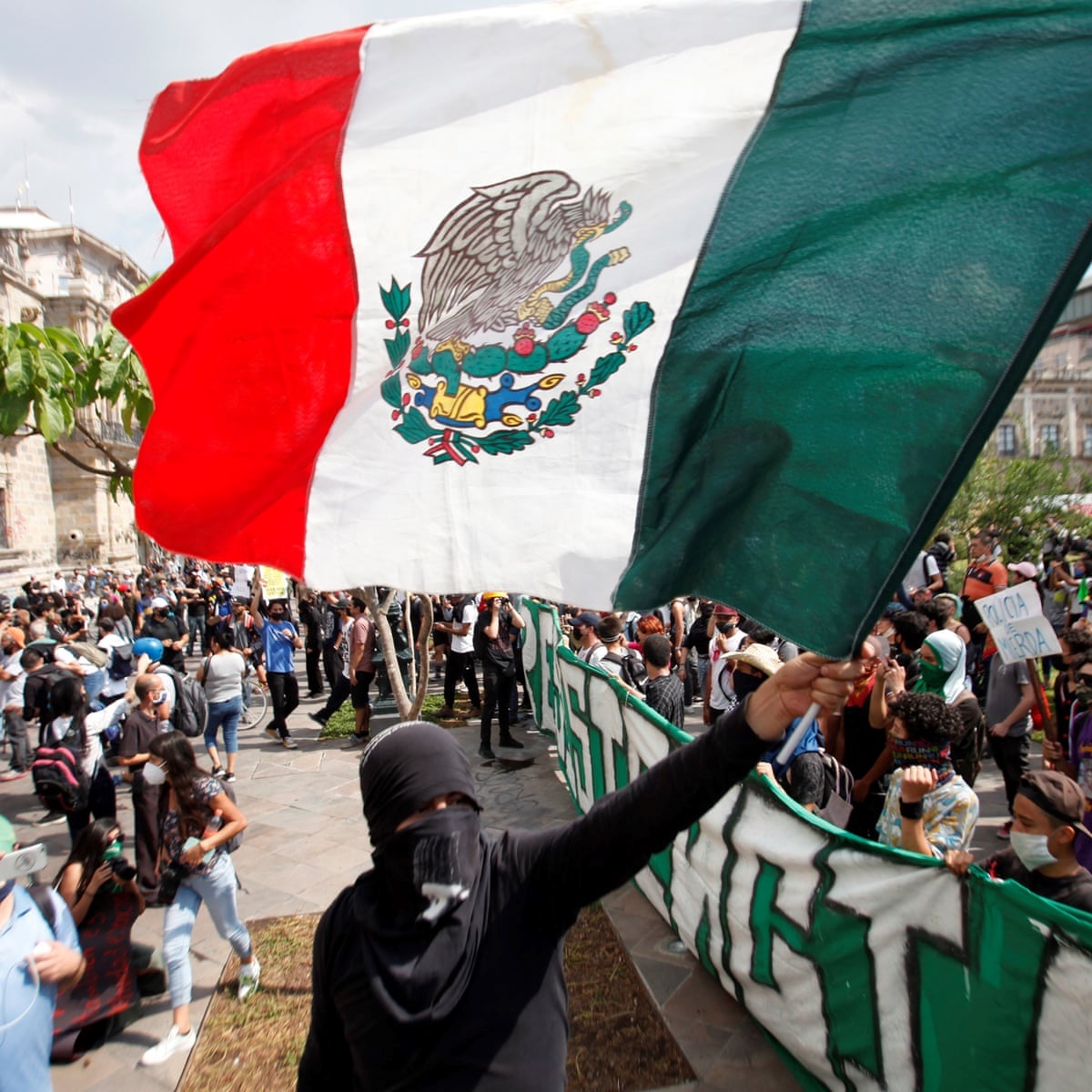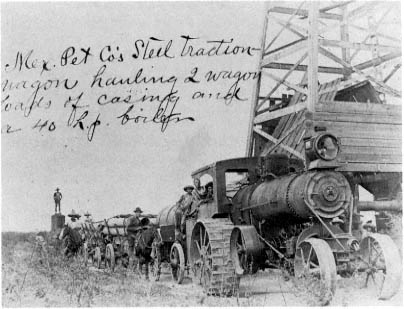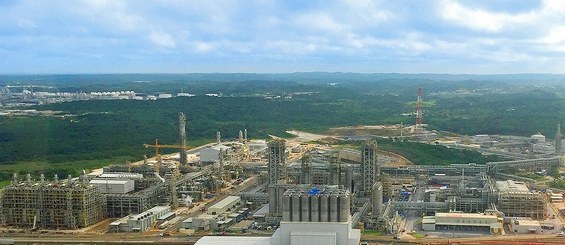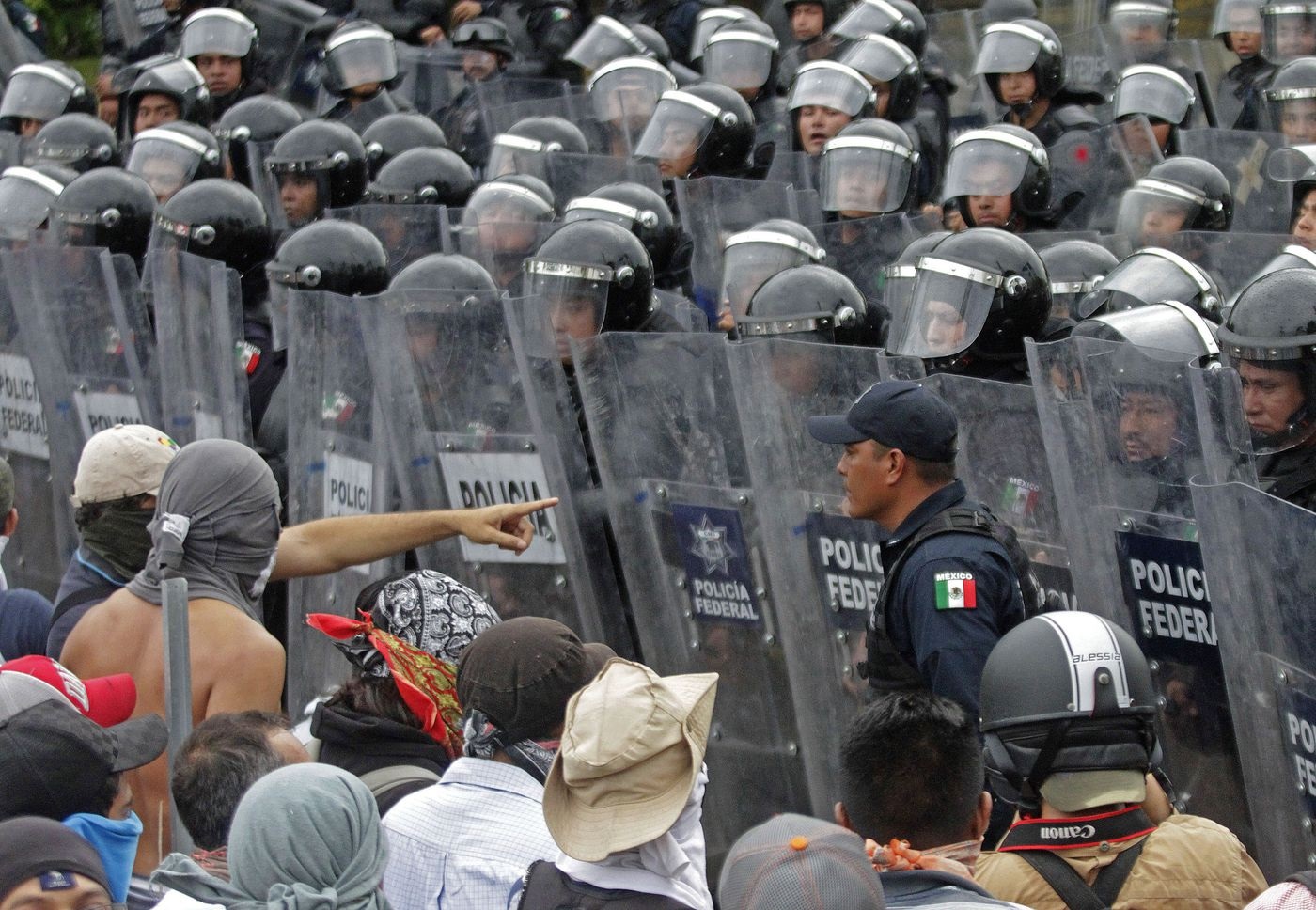
Mexico is a lush nation, rich in subsoil – and yet it is a very poor nation: a state continually overwhelmed by riots, massacres by criminal gangs and rebel armies, with a weak and corrupt central government, which settles contentious issues by shooting at crowds. What unites the nation, even more than a nationalist foundation due to the eternal opposition to the American giant, is its pride in its energy independence, due to its exceptional gas and oil deposits. As the January 2017 riots showed, the fact that oil revenues are not redistributed among the people, but used to finance the federal public debt and the expensive toys of corrupt politicians, punctually brings the population to the streets, ready for anything, in a mixture of anger and despair.
Because Mexico is the country where control over oil has been “inseparable from the concept of nationhood” for almost two hundred years: a “political passion” rather than an economic one, transformed from a symbol of “domination and foreign interference” into a symbol of “pride, self-respect and independence”[1]. The Mayas, the Aztecs and even the Olmecs, 1500 years before Christ[2], had already discovered it (“surviving documents and other material evidence show that pre-Hispanic Mesoamerican peoples collected, processed and used bitumen for various purposes, such as decoration, sealing, waterproofing and as an adhesive”[3]), but soon after the invasion, the exploitation of the wells became the exclusive property of the Spanish Crown[4].
Otherwise, the oil flooded the jungle with the so-called chapopoteras, “zones characterized by the presence of “eternal fires”, by others as “eyes of tar” or “black, viscous and fetid lagoons” and as “unpleasant thick swamps” where, if the animals had fallen, they would have died without remedy”[5] . The Aztecs used it against halitosis and in ritual practices[6], as an illuminant that protects against mosquitoes, and finally as a waterproofing agent for floors and walls[7]. Industrial exploitation began in 1884, under Mexican President Porfirio Diaz, with the first oil concessions voted by Congress to foreign companies, and was renewed in 1901[8].
The oil concessions were one of the triggers of a decade-long civil war, which became famous for the deeds of the rebel Emiliano Zapata, who fought for the nationalisation of the oil fields, the end of large landed estates and all the libertarian ideals of the peasant movements that arose and prospered during the years of dictatorship[9]. An iconic image taken up at the end of the 20th century by the Chiapas rebels, organised under the banner of the EZLN Zapatista Army of National Liberation[10].
PEMEX is born

The first oil well to be nationalised in 1938 – the El Ebano well, opened in 1902[11]
PEMEX (an acronym for Petróleos Mexicanos), founded as a state-owned company under the name Mexican Petroleum Co. on 18 March 1938[12], a creation of the army, strongly desired by General Lázaro Cárdenas del Rio, Mexican President from 1 December 1934 to 1 December 1940 – still considered the most popular man in the national political history[13], especially for his agrarian reform (with the end of latifundism)[14] ,for the nationalisation of the oil industry[15], for welcoming the Spanish Republicans fleeing the civil war[16] and, above all, for containing United States imperialism in foreign policy[17].
Pemex has long been a major source of revenue for the government, contributing up to over a third of the national budget (37% in 2007 [18]), although its contribution to the national GDP has declined with the overall growth of the Mexican economy in the 21st century[19] . However, this decrease is also due to major structural problems of a company that has not been able to modernise itself, so much so that, at the end of 2021, there are faces in the press to reassure the population about Pemex’s ability to cover the national energy needs[20] .
The first oil fields were discovered in 1890, and the first well went into operation in 1901[21] in Ebano: thus began a real race for oil, which led Mexico, in 1928, to be the second largest producer of hydrocarbons in the world[22], with 85 active companies, including PanAm, Gulf, Texaco, Sinclair, Jersey Standard, Standard of Indiana, BP and Shell[23] . After that date, the explosion of violent protest movements and the onset of strong political instability led to the collapse of production[24]. This production debacle was caused not only by the domestic political situation, but also by the introduction of laws to protect workers and rail transport costs, which drove up production costs dramatically, and then the enactment of laws against financial speculation[25].
In any case, the Mexican oil boom coincided with the definitive take-off of the oil industry worldwide, brought about by the growing production of fuel for engines, especially marine engines, and the impetus provided by the growth of the automobile sector and the birth of aviation[26]. The entry into force of the new laws corresponds to the end of a quarter of a century in which Mexico has been overwhelmed by a dozen coups d’état[27]. Each political revolution has brought with it an increase in excise duties, because each rebel army, once in power, has paid its debts with oil revenues[28].
The birth of Pemex is the sign of the end of the period of artisanal and wild exploitation, and the attempt to regularise the entire sector by nationalising the fields[29]. The decision to nationalise was taken after discovering that the workers did not benefit from any form of protection, that they earned 90% less than the American average, with no health care, no pension – and with a tax fraud perpetrated by foreign companies amounting to 150 million pesos behind them: an immense sum, if we think that it cost 26 million pesos to satisfy the just demands of the workers[30].
Even today, Pemex has a licence for 97% of Mexico’s oil wells[31] and, after the crisis years, a programme of exploration and prospecting (for example in the states of Tabasco and Chiapas, and off the Bay of Campeche in the Gulf of Mexico[32]), Between 1976 and 1982, Pemex tripled its crude oil production[33], returned to being a major oil exporter[34] and, after a series of years of fluctuating results[35], reached a record 3.4 million barrels per day in 2004[36]. From then on, things started to go wrong again, so much so that, in 2019, production had dropped by 80% compared to 2004[37]. State deficits and corruption have eaten away at profits, and it has not been possible to modernise plants or open new ones, so in 2014 the door was reopened to multinationals[38].
1979: the Campeche Bay disaster

What remains of the Ixtoc drill, years after the accident[39]
The Gulf of Mexico is an important subsystem within a large marine ecosystem[40]. Because of its biodiversity, it is a strategic area in Mexico’s national plans for economic development. The discovery of fossil fuel reserves on the seabed in the 1970s accelerated the expansion of the national oil industry until, in 1979, a dramatic explosion occurred in the Ixtoc exploratory well due to gas infiltration during drilling and the failure of the safety system[41]. Despite the prompt intervention of the operators, one of the largest oil spills in history was recorded[42]. The clean-up of the entire area cost Pemex 100 million dollars, despite the fact that it avoided prosecution of the claims[43]. The well erupted for 297 days, discharging almost 3 million barrels of oil into the Gulf of Mexico, all the way to the Texas coast, before the hole was sealed with cement[44]. The real causes of the accident are still unknown[45]. Attempts to assess the extent of environmental damage have failed due to a complete lack of official and verifiable data[46].
1992: The Guadalajara explosions

The trail of devastation left by the explosions in Guadalajara[47]
After a lengthy investigation by the judiciary[48], four Pemex executives, the mayor of the city and a number of officials are held responsible for the nine gas explosions that took place in Guadalajara in April 1992, destroying 20 city blocks in the centre of Mexico’s second-largest city and killing 194 people. In order to avoid trouble, they had failed to deal with persistent gas fumes and the report by technicians who had foreseen the possibility of an explosion in the sewage system, which had been infiltrated by the gas[49].
The gas comes from leaks in the Pemex pipeline, and the security situation is so absurd that, during the investigation, it is not even possible to understand which gas has been poured into the sewers[50]: “In Mexico City, (…) Pemex and private companies could share responsibility for the explosions. (…) More than one type of gas may have been involved. Several inner city neighbourhoods were evacuated after Pemex workers discovered that gasoline leaking from a pipeline was seeping into a busy inner city street. The pipeline (…) runs under the exploded sewer line”[51]. The conclusion of the investigation is unequivocal: “the loss of life could have been avoided if officials had acted responsibly and initiated an evacuation of the area”[52].
The turmoil that followed the release of the judiciary report led to the mayor and officials involved resigning and seeking to leave the country[53]. The judicial process was lengthy and in the end the victims were mocked: those responsible for the disaster went unpunished[54]. On 10 October 1997, the Inter-American Commission on Human Rights (IACHR) denounced Mexico for the negligence of Pemex employees[55]. In the same petition, they held the State of Mexico responsible for the subsequent failure to investigate the facts, for leaving the guilty unpunished and for acts of repression against those who demanded justice[56].
2012-2013: the incidents in Reynosa and Ciudad do Mexico

The explosion scene in Reynosa[57]
On 19 September 2012, an explosion at Pemex’s natural gas distribution plant in Reynosa, on the US-Mexico border, killed 30 people and injured 46, causing a wave of indignation because the dead workers were not Pemex employees, but workers from companies operating on a piecework basis and unqualified[58], a choice due to Pemex’s lack of liquidity[59]. There is a suspicion that the accident was due to a failed attempt to steal fuel (a problem that Pemex has been facing for years[60]). The fact is that, for the umpteenth time[61], the security systems failed, so that no one realised it was about to happen[62].
On 31 January 2013, in an explosion at the Pemex administrative offices in Mexico City, 37 people were killed and 126 injured – again from causes that were never identified[63], although there were suspicions that it was an attack[64]. The political reactions brought the government close to collapse[65], and to a series of conspiracy theories, such as that of an attack by the Las Zetas criminal gang[66], which for years has been exploiting Pemex’s weak infrastructure by stealing hydrocarbons to resell them as contraband, costing the company about 1 billion dollars a year[67]. In the United States, operators who sell oil and hide the proceeds of smuggling on behalf of Las Zetas are being arrested[68], which has also led to a wave of violence and arrests in Mexico[69].
However, the list of incidents, or alleged incidents, involving Pemex has continued to lengthen over the years, with a fire on the Abkatun A platform in the southern Gulf of Mexico on 1 April 2015, and a large explosion and fire at the company’s Chlorinate 3 plant in Coatzacoalcos on 20 April 2016, the fire on the tanker “Burgos” off Boca del Río on 24 September 2016, an explosion on a pipeline passing through the village of Tlauhuelilpan (Hidalgo) on 18 January 2019, the explosion of a pipeline owned by Pemex in the Gulf of Mexico on 2 July 2021 followed by an oil rig fire on 24 August[70].
2014: Operation Car Wash

The huge Ethylene XXI plant, for the construction of which millions were paid in bribes[71]
The ‘Car Wash’ operation (Operação Lava Jato) is an investigation by Brazil’s federal police, which began in March 2014 and ended in February 2021: it started as a money laundering investigation and has expanded to include corruption linked to the Brazilian oil company Petrobras, takes its name from the fact that the first search was carried out in a car wash in Brasilia, and over time has also expanded to include illegal acts linked to foreign companies, such as Pemex[72]. In the crosshairs of the judiciary are four contracts signed by the Mexican company with the Brazilian commercial group Odebrecht: a) one signed in February 2010 with Braskem and GrupoIdesa for the supply of ethanol for the Ethylene XXI complex in Coatzacoalcos; two signed in February 2014 and November 2015 for the construction of the Miguel Hidalgo Tula I and Tula II refineries; and finally one signed in November 2014 to upgrade the Salamanca refinery[73].
The analysis of the Brazilian documentation launched a new investigation, this time limited to Mexico[74] . The former CEO of Pemex has fled to Spain, and the outcome of an extradition procedure is now awaited[75] . Numerous managers of the oil group are being investigated, and this opens the door, of course, to criminal investigations into the presidents who personally appointed them[76].
Human rights violations

Federal police prepare to attack rioting Pemex workers[77]
All this is happening against a backdrop of repeated human rights violations, summed up in one iconic example, that of a worker who was refused medical care in a Pemex hospital because his son is a member of the UNTyPP Unión Nacional de Técnicos y Profesionistas union[78], and the subsequent decision to refuse treatment to cancer patients who have union cards in their pockets[79]. To date, anyone who joins UNTyPP loses their job, which means thousands of skilled workers who have been thrown out on the street[80], legally persecuted[81] and even cyber-attacked to destroy the data they hold on their personal computers[82].
Fortunately, in 2021 it joined an international agreement with Canada and the United States, which protects workers’ rights, prohibits consecutive 32-hour shifts (which are the norm for Pemex), harassment and personal violence, and indiscriminate dismissals[83]. A humiliation for the Mexican political class, but also for the people, who are forced to seek justice from their hated neighbours in the United States. Because, in the threatening evolution of a country divided by undying hatreds, torn apart by the power of criminal gangs, bloodied by civil strife between army and rebels, with a megalopolis as its capital that has long since gone beyond the limits of tolerance of the ecosystem and, like Mumbai, has turned into a trap, and not only for the poorest, Mexico knows of local protest movements, but no secessionist organisation. If there is one thing a Mexican knows, it is that he loves his country, and that he needs an oil company that works, and allows him to live in peace.
[1]lan Riding, “DistantNeighbors: A Portrait of the Mexicans”, Vintage Books, New York 1989
[2]Michael D. Coe, “America’s first civilization: Discovering the Olmecs”, The Smithsonian Library, New York 1968
[3]https://www.researchgate.net/profile/Carl-Wendt/publication/223561773_How_the_Olmec_Used_Bitumen_in_Ancient_Mesoamerica/links/5ed93889458515294531eecd/How-the-Olmec-Used-Bitumen-in-Ancient-Mesoamerica.pdf?origin=publication_detail
[4]https://civiltaprecolombiane.wordpress.com/civilta-degli-olmechi/
[5]María C. Rosano Hernández ,“El chapopote y las chapopoteras del Golfo de México. Reseña sobre el descubrimiento y usos del petróleo”. Primera edición, México 2013 D.R. ©. 2012, Instituto Mexicano del Petróleo. https://backend.aprende.sep.gob.mx/media/uploads/tmp/resources/SEN11-2013-LB01.pdf
[6]Questo rito era legato, secondo lo specialista, al culto di Tezcatlipoca, divinità azteca del cielo notturno, creatrice e allo stesso tempo distruttrice, legato alla purezza e al peccato, inventore del fuoco e protettore dei principi.” https://www.inah.gob.mx/en/boletines/3126-chapopote-uso-milenario
[7]https://www.inah.gob.mx/en/boletines/3126-chapopote-uso-milenario
[8]https://www.memoriapoliticademexico.org/Efemerides/12/24121901.html
[9]John Womack Jr., “Zapata and the Mexican Revolution”; Vintage Books, New York 1968
[10]Juan Ponce de Leon, “Our word is our weapon, selected writings off Subcomandante Marcos”, Seven Stories press, New York 2001
[11]https://publishing.cdlib.org/ucpressebooks/view?docId=ft3q2nb28s;chunk.id=0;doc.view=print
[12]https://www.udg.mx/es/efemerides/18-marzo
[13]https://it.thpanorama.com/blog/historia/lzaro-crdenas-del-ro-biografa-y-caractersticas-de-su-gobierno.html ; https://historiamexicana.colmex.mx/index.php/RHM/article/download/865/756https://inehrm.gob.mx/recursos/Libros/Lazaro_CardenasMLT1.pdf pag.15
[14]https://inehrm.gob.mx/recursos/Libros/Lazaro_CardenasMLT1.pdf pp.321-334
[15]https://inehrm.gob.mx/recursos/Libros/Lazaro_CardenasMLT1.pdf pp.345-353
[16]https://www.reteparri.it/wp-content/uploads/ic/IC_248_2007_2_r.pdf
[17]Le americhe e la civiltà”, di Darcy Ribeiro, ed.Einaudi, Torino, 1975, pag.146-150
[18]https://www.confindustria.pu.it/allegati/monografie/200804_messico.pdf
[19]https://oilgasnews.it/nel-2021-i-ricavi-di-pemex-saranno-di-64-000-milioni-di-euro/
[20]https://oilgasnews.it/nel-2021-i-ricavi-di-pemex-saranno-di-64-000-milioni-di-euro/
[21]https://it.thetopknowledge.com/petrleos-mexicanos-mexican-company
[22]https://www.theblackbag.org/golfo-messico/
[23]https://www.areadiservizio.eu/wp-content/uploads/2020/10/AdS_5_2020_web.pdf pp. 90-92; Mario Monti, L’Italia e il mercato mondiale del petrolio, Tipografia Sallustiana, 1930
[24]https://www.areadiservizio.eu/wp-content/uploads/2020/10/AdS_5_2020_web.pdf pp. 90-92.
[25]https://www.areadiservizio.eu/wp-content/uploads/2020/10/AdS_5_2020_web.pdf
[26]J. Noriega, “Influencia de los hidrocarburos en la industialización de México”, Vol. 3 (México D.F., 1944), p. 211
[26]https://web.stanford.edu/class/polisci313/papers/Haber-RazoFeb25.pdf[27]https://web.stanford.edu/class/polisci313/papers/Haber-RazoFeb25.pdf
[28]México y EstadosUnidos en el conflictopetrolero (1917-1942)” pp. 34 e seguenti https://www.cervantesvirtual.com/obra/mexico-y-los-estados-unidos-en-el-conflicto-petrolero-1917-1942-924444/
[29]https://www.udg.mx/es/efemerides/18-marzo
[30]https://www.udg.mx/es/efemerides/18-marzo
[31]https://sicurezzainternazionale.luiss.it/2020/01/23/la-produzione-petrolio-del-messico-diminuita-del-7-nel-2019/
[32]https://www.britannica.com/place/Mexico/World-War-II-1941-45; https://earthobservatory.nasa.gov/images/79153/gas-flares-in-bahia-de-campeche
[33]“The Mexican Oil Boom: 1977-1985” Michael Gavin, Office of the Chief Economist Inter-American Development Bank P.6 https://core.ac.uk/download/pdf/6441657.pdf
[34]Area di Servizio, n. 5/2020, pp. 90-92. https://www.areadiservizio.eu/la-rivista/
[35]https://www.ageitalia.net/uploads/services/docs/sv0624-5e91536e31428.pdf P.7 ed https://www.statista.com/statistics/543590/crude-oil-production-of-pemex/
[36]https://sicurezzainternazionale.luiss.it/2020/01/23/la-produzione-petrolio-del-messico-diminuita-del-7-nel-2019/
[37]https://sicurezzainternazionale.luiss.it/2020/01/23/la-produzione-petrolio-del-messico-diminuita-del-7-nel-2019/
[38]https://oilgasnews.it/pemex-e-al-nono-posto-tra-le-aziende-piu-indebitate-al-mondo/
[39]https://www.westend61.de/en/imageView/CUF48041/reef-life-and-old-wrecks-alacranes-campeche-mexico
[40]Sherman, K. (1994). Sustainability, biomass yield, and health of coastal ecosystems: an ecological perspective. Mar. Ecol. Progr. Ser. 112, 277–301; Kumpf, H., Steidinger, K., and Sherman, K. (1999). The Gulf of Mexico Large Marine Ecosystem: Assessment, Sustainability and Management. Malden, MA: Blackwell Science Ltd., 704
[41]https://www.reuters.com/article/idUSTRE64N57U20100524
[42]https://www.reuters.com/article/idUSTRE64N57U20100524
[43]https://www.reuters.com/article/idUSTRE64N57U20100524https://tind-customer-berkeleylaw.s3.amazonaws.com/f7d46cf1-09d7-4a29-9a02-bff74d66862e?response-content-disposition=attachment%3B%20filename%2A%3DUTF-8%27%27fulltext.pdf&response-content-type=application%2Fpdf&X-Amz-Algorithm=AWS4-HMAC-SHA256&X-Amz-Expires=86400&X-Amz-Credential=AKIAXL7W7Q3XNDXVUP4O%2F20220401%2Feu-west-1%2Fs3%2Faws4_request&X-Amz-SignedHeaders=host&X-Amz-Date=20220401T155044Z&X-Amz-Signature=c43ff8e4d83989871403186a1d55e95767145ff9bafe1b53382913be8a684aba; https://www.congress.gov/94/statute/STATUTE-90/STATUTE-90-Pg2891.pdf§ 1604 con eccezioniprevistedai§§ 1605-1607 in Chapter 97.—JURISDICTIONAL IMMUNITIES OF FOREIGN STATES
[44]https://www.reuters.com/article/idUSTRE64N57U20100524
[45]https://www.reuters.com/article/idUSTRE64N57U20100524
[46]https://fjfsdata01prod.blob.core.windows.net/articles/files/116502/pubmed-zip/.versions/1/.package-entries/fmars-01-00057/fmars-01-00057.pdf?sv=2018-03-28&sr=b&sig=AQNsoofYyjj1Can%2BLCty3Lu9NjpMNEFRmiOUXUZlGfA%3D&se=2022-04-01T11%3A28%3A34Z&sp=r&rscd=attachment%3B%20filename%2A%3DUTF-8%27%27fmars-01-00057.pdf
[47]https://alchetron.com/1992-Guadalajara-explosions
[48]The Damnificados of Guadalajara: The Politics of Domination and Social Movement Protest” di John Shefner e John Walton, in International Journal of Urban and Regional Research, 1993 pp. 611-621
[49]https://web.archive.org/web/20080309011900/http://www.time.com/time/magazine/article/0,9171,975488,00.html
[50]https://www.latimes.com/archives/la-xpm-1992-04-25-mn-878-story.html
[51]In Mexico City, a top government official suggested that Pemex and private companies may share responsibility for the explosions. The official, who asked that his name not be published, added that more than one type of gas may have been involved. In a new development, several neighborhoods in the city center were evacuated Thursday and Friday after Pemex workers discovered that gasoline leaking from a pipeline was seeping onto a busy downtown street. The pipeline is used to transfer gasoline from a nearby Pemex storage facility and runs under the sewer linethat exploded” da Los Angeles Times 25 April 1992 https://www.latimes.com/archives/la-xpm-1992-04-25-mn-878-story.html
[52]https://www.latimes.com/archives/la-xpm-1992-04-27-mn-630-story.html
[53]https://www.latimes.com/archives/la-xpm-1992-04-27-mn-630-story.html
[54]http://hrlibrary.umn.edu/cases/17-03.html
[55]http://hrlibrary.umn.edu/cases/17-03.html
[56]http://hrlibrary.umn.edu/cases/17-03.html
[57]https://www.agweb.com/news/machinery/100-ideas/reynosa-pipeline-rupture-sends-us-natural-gas-south
[58]https://digitalrepository.unm.edu/cgi/viewcontent.cgi?article=1014&context=la_energy_notien
[59]https://digitalrepository.unm.edu/cgi/viewcontent.cgi?article=1014&context=la_energy_notien
[60]https://digitalrepository.unm.edu/cgi/viewcontent.cgi?article=1014&context=la_energy_notien
[61]https://digitalrepository.unm.edu/cgi/viewcontent.cgi?article=1014&context=la_energy_notien
[62]https://digitalrepository.unm.edu/cgi/viewcontent.cgi?article=1014&context=la_energy_notien
[63]https://www.nytimes.com/2013/02/01/world/americas/explosion-in-mexico-city-at-oil-company-headquarters.html
[64]https://www.nytimes.com/2013/02/01/world/americas/explosion-in-mexico-city-at-oil-company-headquarters.html; https://insightcrime.org/news/analysis/pemex-blast/
[65]https://insightcrime.org/news/analysis/pemex-blast/
[66]https://insightcrime.org/news/analysis/pemex-blast/ ; https://www.repubblica.it/esteri/2013/07/17/news/zetas_lorgia_del_potere_narcos-63136477/ ; https://valori.it/narcos-petrolio-bond-spazzatura-messico/
[67]https://insightcrime.org/news/analysis/pemex-blast/ ; https://insightcrime.org/news/analysis/oil-theft-is-big-business-for-mexican-gangs/ ; https://insightcrime.org/news/analysis/two-attacks-on-pemex-highlight-increasing-dangers/
[68]https://insightcrime.org/news/analysis/pemex-blast/
[69]https://www.repubblica.it/esteri/2013/07/17/news/zetas_lorgia_del_potere_narcos-63136477/
[70]https://es.wikipedia.org/wiki/Petr%C3%B3leos_Mexicanos#V%C3%A9ase_tambi%C3%A9n
[71]https://www.ulmaconstruction.com/en/projects/industrial-energy-structures/ethylene-xxi-production-plant-%20coatzacoalcos-veracruz-mexico
[72]https://www.chemanager-online.com/en/news/pemex-details-contracts-car-wash-probe
[73]https://www.chemanager-online.com/en/news/pemex-details-contracts-car-wash-probe
[74]https://www.upstreamonline.com/politics/lozoya-case-could-be-mexicos-car-wash/2-1-854380
[75]https://elpais.com/mexico/2022-01-26/el-exdirector-de-pemex-emilio-lozoya-seguira-en-prision-por-el-caso-odebrecht.html ;https://www.upstreamonline.com/politics/lozoya-case-could-be-mexicos-car-wash/2-1-854380
[76]https://www.upstreamonline.com/politics/lozoya-case-could-be-mexicos-car-wash/2-1-854380 ; https://www.upstreamonline.com/politics/energy-reform-rollback-threat-raises-alarms-in-mexico/2-1-854222
[77]https://www.vox.com/2014/11/12/7194603/mexico-protests-iguala-massacre
[78]https://arquidiamantina.org/it/pemex-italiano/
[79]https://arquidiamantina.org/it/pemex-italiano/
[80]https://www.industriall-union.org/archive/imf/pemex-workers-forced-to-resign-from-union
[81]https://arquidiamantina.org/it/pemex-italiano/
[82]https://arquidiamantina.org/it/pemex-italiano/ ; https://www.pcrisk.it/guide-per-la-rimozione/9456-doppelpaymer-ransomware
[83]https://ustr.gov/trade-agreements/free-trade-agreements/united-states-mexico-canada-agreement/agreement-between e https://www.cbp.gov/sites/default/files/assets/documents/2020-Sep/USMCA%20Implementing%20Instructions%20%28CBP%20Pub.%20No.1118-0620%29%20%282020-06-30%29_ES.pdf; https://www.business-humanrights.org/es/últimas-noticias/méxico-unión-nacional-de-técnicos-y-profesionistas-petroleros-untypp-denunciarán-a-petróleos-mexicanos-pemex-en-l%C3%ADnea-roja-del-t-mec-por-violaciones-a-derechos-laborales/
Leave a Reply